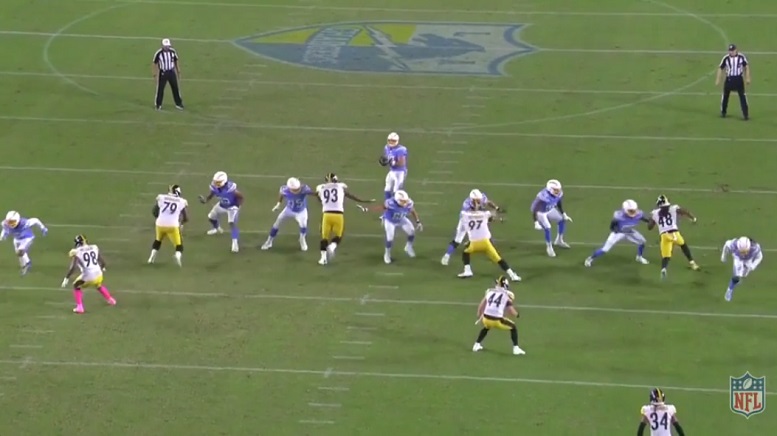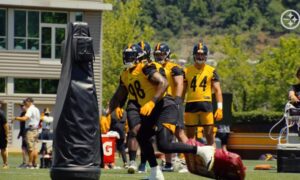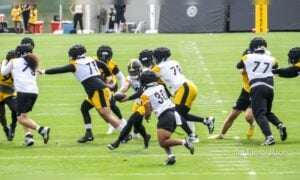Anyone regular reader of these pages during the draft saw a number of intense discussions about the nature of the Steelers defense, the Dupree-vs-Hargrave debate, and then the need/desire for someone to replace our lost Gravedigger. Some people argued that Pittsburgh desperately needed that Nose Tackle, and should spend a premium pick on the next Casey Hampton. Others wanted a Hargrave clone – not immovable, but rather quick, able to penetrate, and good enough to step in for Heyward or Tuitt in the case of injury. The third school took the argument half a step further, arguing that the modern defense had merged both “Nose Tackle” and “Defensive End” into a single group best called “Defensive Tackles”; a term hitherto reserved for the central pair of linemen in a 4-3 defense. This last position argued that even using the terms NT and DE was deceptive, because they were now geographic descriptions more than positions.
Those discussions have continued since then. I am now ready to take a firm stance on the matter. I vote for camp #3. The Steelers have two and only two starting Defensive Tackles: Cam Heyward and Stephon Tuitt. In that sense we now play something that looks like a 4-man front. The classic 3-man front is now a favorite sub-package, getting up to a third of the overall snaps. It is no longer the “base defense,” but rather a favorite pitch in Keith Butler’s arsenal of changeup pitches.
Does It Matter?
One can make a good argument that the entire debate is academic. Who cares if the defensive front are called DT’s, NT’s, or DE’s? Who cares if the designated rushers off the edge are called OLB’s or DE’s? The players need to focus on specific tasks, not arbitrary titles to describe geographic locations. Shouldn’t we do the same?
I agree with that argument at a basic level, but it ignores the real-world consequences that go along with those titles. Just ask Bud Dupree, who has a very legitimate appeal pending with the PTB’s (Powers That Be) over what he should be paid under the franchise tag. It turns out there is something like a $2-$3 Million difference based on whether he’s called an Outside Linebacker or Defensive End, notwithstanding the fact that he is one of the team’s designated edge rushers regardless of title. The Steelers have called him an OLB from the get-go; but his duties look more like the DE on a 4-man front; but he plays from a two point (a/k/a standing) position; but… [argh]. Bottom line: the PTB’s need to allocate real money even if the words no longer have a meaning.
These titles also matter at our (semi)real fan level, because fans delight in trying to follow what the GM’s and coaches of the world are up to. I admit to being more of a play-level GM myself. My primary interest lies in the draft, and building the best possible team-on-paper. But just as Kevin Colbert has no doubt forgotten more about X’s and O’s than any of us will ever learn, so that interest requires me to understand modern defensive philosophy. You too if you’re still reading this.
And, of course, there are going to be fan-level coaches in this community, and real coaches at a lower level. Thus I conclude that the distinctions matter at our level even if they are academic in the sense of being true theory rather than X’s and O’s reality. Theory informs reality and vice versa.
It Comes Down To The Changes In Modern Offense
The 3-4 and 4-3 systems evolved as two parallel ways to stop the offenses that won Super Bowls in the 1960’s, 70’s, 80’s, and 90’s. The dominance of those two formations began to change in the 2000’s; the change accelerated in the 2010’s; and that brings us to date. So what makes me so sure that half a century of nomenclature has now become dated? One simple reason: the pass happy modern NFL, as exemplified by the fact that almost all offenses use 11 personnel as their base rather than 21 personnel.
Time to back and fill with some definitions. The rules say that an offense must have five offensive linemen on the field at any given time. That leaves room for six “skill players”; a QB plus some combination of five men at the RB, TE, and WR positions. Those “heavy” formations with six or seven OL’s? They happen when the offense brings in a 350 pound “Tight End”, who conveniently lines up with his hand in the dirt. He’s wearing a number that says “Lineman”, but he is playing a position that is allowed to catch passes, and thus the defense and the fans need to be formally warned with the announcement that “so-and-so has registered as an eligible receiver.”
The offensive personnel packages are named according to the number of RB’s and TE’s, with all the rest being assumed (a single QB) or inferred (the rest of the players are WR’s). Thus 11 personnel means “one RB and one TE”. That leaves room for one QB three WR’s to fill out the formation. 21 personnel means two RB’s and one TE, leaving room for the QB and only two WR’s. 12 personnel is one RB and two TE’s; 22 personnel is two of each; etc. [An aside: Lamar Jackson’s ability to double as an extra RB essentially lets Baltimore create novel personnel packages on the fly, and as plays break down. That “extra” player is what gave defenses such angst last year.]
For most of the past 60 years, “pro offense” meant 21 personnel: five OL’s, two RB’s (halfback and fullback), on QB, and two WR’s. Think of the 70’s Steelers, with Franco Harris and Rocky Bleier in the backfield, Swann and Stallworth as the WR’s, and Randy Grossman at TE. That was the central theme on which theorists created their riffs and variations.
In the past 15-20 years, fullbacks have been replaced by either a third WR (11 personnel) or a TE/WR hybrid (21 personnel with an asterisk). The net result is less power running up the middle, and more passing. That is the underlying mechanism behind the “pass happy league.”
Defenses responded by going to the “Nickel” more and more often. Recall that the “3-4 base defense” is actually a 3-4-4 if written out in full. Three DL’s, four LB’s, and four DB’s. The “4-3 base” is a 4-3-4, in just the same way. “Nickel” defenses increase the number of DB’s from four to five. For 3-4 teams that meant removing the NT, to create a 2-4-5 formation. 4-3 teams removed a LB, thus turning into a 4-2-5. What is the difference between those two? I dunno, but Bud Dupree has an appeal pending on just that point.
In any case, the Steelers and all the rest of the NFL now play some variation on the Nickel defense for most of their snaps because that is the countermove for the now dominant 11 personnel offenses. The nomenclature has lagged behind because it’s hard to call the 2-4-5 a “base formation” when the “four” and the “five” (LB’s and DB’s) have started to rely on hybrid players who straddle the line. Teams used to have a big, run-stuffing Buck ILB paired with a mobile Mack ILB (Strong and Weak LB’s for in 4-3 lingo), but nowadays those two geographic spots may instead be manned by two Macks, or a Mack and a Box Safety. It gets even more fractured when you realize that the five DB’s may include anywhere from 2-4 Corners.
Bottom line: there is no single personnel package that is on the field often enough to deserve the name “base”.
So What Terminology Should We Use?
Does all this create a Catch-22? We require a language to describe our defense, and to figure out what could improve it; but there are no words to describe how modern defenses are organize. Heck, how do we even define what “starter” means in the modern NFL?
And *THAT* my friends was the question that led to this article!
What if we define “starter” by looking at snap counts instead of positions? It works!
There are something like 1100-1200 defensive snaps over the course of an NFL season. If we define “starter” as someone who would play more than two thirds of those (800+), you end up with this as the base defense: 2-3-4-plus-2 (a/k/a 4-1-4+2 if you agree with Bud Dupree’s position in the appeal). Two DT’s (Heyward and Tuitt); two edge rushers an an ILB (Watt, Dupree, and Bush); four DB’s (Haden, Nelson, Fitzpatrick, and Edmunds); plus two floating positions that vary according to package. NT, Buck ILB, Safety #3, Slot CB, and CB #4 all get de- or promoted to the status of “package player”, two of which will be on the field at any give time.
How does this matter? Well, for one it allows us to take a deep breath and relax about the loss of Javon Hargrave. I adored that pick and loved having the Gravedigger here as a Steeler, but absent an injury he was never a starter; just a really amazing part of the package-player array. Same thing for the oft-maligned and occasionally oversold package players like Vince Williams, Mike Hilton, and Cam Sutton. They are all role players in the modern defense, not starters, and thus a step down in priority compared to the chance of losing a guy like Dupree. And/or starters-in-waiting if you want to take a longer term POV.
This view of the modern base defense also explains the team’s willingness to put the franchise tag on Dupree. Say what you will about underachieving, he is a true starter who played 980 snaps in 2019. Hargrave may well be better at playing on the defensive line than Dupree is at playing the edge rusher spot, but starters are worth more than package players every single time.
Then there’s the place we started: the ongoing clamor for a Nose Tackle. Well… look at Dupree’s appeal again. If he and Watt put their hand in the dirt, and you have a classic 4-man front. Pittsburgh got by fine in the 1970’s with a four man front, and could do so again in a pinch. The “missing” NT does not create an automatic hole against teams that want to run between the tackles. Adding a good NT provides a lot of flexibility to mix in 3-4 concepts, thereby making the defense less predictable, but that is (again) a question of enhancing how many defensive packages can be built and how strong each one will be.
What about the style of NT? Should we look for an immovable object, or a one-gap penetrator? My analysis suggest that this is a mere subtlety, since the player in question is looking at no more than 200 snaps regardless of his skill set. But maybe we should give a slight edge toward the penetrator in order to double as a backup behind Heyward & Tuitt.
Finally, this viewpoint clarifies why the team needs to keep focusing on hybrid athletes who can straddle the line between box Safety and Mack ILB, and between Safety #3 and slot CB. Those hybrid players do for a defense what Lamar Jackson does for the Baltimore offense. They allow a seamless transition from one package to a very different one without any telegraphing to the offensive play callers. Disguise and flexibility are the key assets once you have the nine true starters in place.
Get used to it folks. The days of the 3-4 base are gone. Pittsburgh plays a package-based defense with nine starters, and five floaters who rotate in and out in order to fill the final two slots. Think of it that way and you’ll be ahead of the curve.








